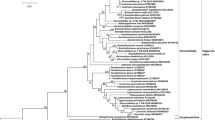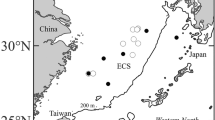Abstract
Members of the genus Crassicauda (Nematoda: Spirurida) are parasites of the body tissues of whales and dolphins. Owing to the large size of worms and difficulties in the recovery of entire nematodes from the tissues of hosts, limited information is available on morphological descriptions of both male and female worms. Furthermore, there are currently no available sequence data for this genus to assist with such identifications. This paper describes for the first time features of the anterior extremity and the male tail of Crassicauda magna, suggesting that Crassicauda duguyi may be a synonym of this species. In addition, molecular data are presented for the genus for the first time suggesting that the genus belongs within the superfamily Acuarioidea rather than within the Habronematoidea, in which it is currently placed.




Similar content being viewed by others
References
Abollo E, López A, Gestal C, Benavente P, Pascul S (1998) Macroparasites in cetaceans on the northwestern Spanish Atlantic coast. Dis Aquat Org 32:227–231
Almeyda-Artigas RJ, Bargues MD, Mas-Coma S (2000) ITS-2 rDNA sequencing of Gnathostoma species (Nematoda) and elucidation of the species causing human gnathostomiasis in the Americas. J Parasitol 86:537–544
Bain O, Mutafchiev Y, Junker K (2014) Order Spirurida. In: Schmidt-Rhaesa A (ed) Handbook of zoology: Gastrotricha, Cycloneuralia and Gnathifera. Walter De Gruyter Inc., Berlin, pp 661–731
Bateman TFK, McLellan W, Piscitelli M, Harms C, Barco S, Thayer V, Clark K, Potter C, Pabst D (2014) Crassicauda infections in kogiid whales. Conf Abs Soc Integ Comp Biol pp 3.110
Blaxter ML, De Ley P, Garey JR, Liu LX, Scheldeman P, Vierstraete A, Vanfleteren JR, Mackey LY, Dorris M, Frisse LM, Vida JT, Thomas WK (1998) A molecular evolutionary framework for the phylum Nematoda. Nature 392:71–75
Chabaud AG (1975) CIH Keys to the nematode parasites of vertebrates. No. 3. Keys to the order Spirurida. Part 2. Spiruroidea, Habronematoidea and Acuarioidea. Commonwealth Agricultural Bureaux, Farnham Royal, pp 29–58
Darriba D, Taboada GL, Doallo R, Posada D (2012) jModelTest 2: more models, new heuristics and parallel computing. Nat Methods 9:772
Delyamure SL (1955) Helminthofauna of marine mammals (Ecology and Phylogeny). Gel’ mintologicheskaya Laboratoria, Akademiya Nauk SSSR, Moskva. English translation: Israel Program for Scientific Translations, Jerusalem, 1968 pp 520.
Dollfus RP (1966) Hélminthofaune de Kogia breviceps (Blainville, 1838), cétace odontocète, récoltés du Dr R. Duguy. Annal Soc Sci Nat Charente-Marit 4:3–6
Drummond AJ, Ashton B, Buxton S, Cheung M, Cooper A, Duran C, Field M, Heled J, Kearse M, Markowitz S, Moir R, Stones-Havas S, Sturrock S, Thierer T, Wilson A (2011) Geneious v5. 4., Auckland, New Zealand. http://www.geneious.com
Duignan PJ (2000). Diseases of cetaceans and pinnipeds. In: Martin A, Vogelnest L (eds) Marine Wildlife. The Fabian Fay Course for veterinarians. Proc 335. Postgraduate Foundation in Veterinary Science, University of Sydney: Sydney pp 431–462.
Honisch M, Krone O (2008) Phylogenetic relationships of Spiruromorpha from birds of prey based on 18S rDNA. J Helminthol 82:129–133
Huelsenbeck JP, Ronquist F (2001) MrBayes: Bayesian inference of phylogenetic trees. Bioinformatics 17:754–755
Johnston TH, Mawson PM (1939) Internal parasites of the pygmy sperm whale. Rec S Aust Mus 6:263–274
Laetsch DR, Heitlinger EG, Taraschewski H, Nadler SA, Blaxter ML (2012) The phylogenetics of Anguillicolidae (Nematoda: Anguillicoloidea), swimbladder parasites of eels. BMC Evol Biol 12:60
Lambertsen RH (1985) Taxonomy and distribution of a Crassicauda species (Nematoda: Spirurida) infecting the kidney of the common fin whale (Balaenoptera physalus Linné, 1758). J Parasitol 71:485–488
Margolis L, Pike GC (1955) Some helminth parasites of Canadian pacific whales. J Fish Res Board Can 12:97–120
Mignucci-Giannoni A, Hoberg EP, Siegel-Causey D, Williams EH (1998) Metazoan parasites and other symbionts of cetaceans in the Caribbean. J Parasitol 84:939–946
Moravec F (2007) Some aspects of the taxonomy and biology of adult spirurine nematodes parasitic in fishes: a review. Folia Parasitol 54:239–257
Nadler SA, Carreno RA, Mejía-Madrid H, Ullberg J, Pagan C, Houston R, Hugot JP (2007) Molecular phylogeny of clade III nematodes reveals multiple origins of tissue parasitism. Parasitology 134:1421–1442
Raga JA, Balbuena JA (1990) A new species of the genus Crassicauda Leiper et Atkinson, 1914 (Nematoda: Spiruroidea) from the penis of Globicephala melas (Traill, 1809) (Cetacea: Globicephalidae) in the western Mediterranean Sea. Ann Parasitol Hum Comp 65:255–261
Ronquist F, Huelsenbeck JP (2003) MrBayes 3: Bayesian phylogenetic inference under mixed models. Bioinformatics 19:1572–1574
Skrjabin AS (1966) A new Crassicauda (Crassicauda delamureana n. sp.) a parasite of the sei whale. Problemy Parazitologii, Kraevaya Parazitologiya i Prirodnaya Ochagovost Transmissivnikh Boleznei. Akademia Nauk Ukranskoi SSSR pp 100–107 [in Russian]
Skrjabin AS (1969) Novaya nematoda Crassicauda costata n. sp.–parazit yshnovo kita. Parazitologiya 3:258–265 [in Russian]
Smythe AB, Sanderson MJ, Nadler SA (2006) Nematode small subunit phylogeny correlates with alignment parameters. Syst Biol 55:972–992
Werle E, Schneider C, Renner M, Völker M, Fiehn W (1994) Convenient single-step, one tube purification of PCR products for direct sequencing. Nucleic Acids Res 22:4354–4355
Wijová M, Moravec F, Horák A, Lukes J (2006) Evolutionary relationships of Spirurina (Nematoda: Chromadorea: Rhabditida) with special emphasis on dracunculoid nematodes inferred from SSU rRNA gene sequences. Int J Parasitol 36:1067–1075
Acknowledgments
We wish to thank Mike Carr, Natalie Reed and Lou Coles of the Moreton Bay Marine Parks Queensland Parks and Wildlife Service (Department of National Parks, Recreation, Sports & Racing) for alerting us to the presence of parasites in the dead whale; Heather Janetzki, Collection Manager (Mammals/Birds), Natural Environments Program, Queensland Museum for facilitating the collection of nematode specimens from the whale parts; Dr Leslie Chisholm of the South Australian Museum for access to material in the museum collections and to Dr K. Rose and J. Hall of Taronga Zoo, Sydney, Australia, for the material from New South Wales. Thanks are also due to Dr D.I. Gibson and Mrs E. Harris, Natural History Museum, London, for access to material in their collection and for information on the taxonomy of the genus and to Prof. J.-L. Justine, Muséum national d’Histoire naturelle, Paris, for access to the types of C. duguyi.
Author information
Authors and Affiliations
Corresponding author
Additional information
Nucleotide sequence data reported in this paper are available in the GenBank database under the accession number KM233410
Rights and permissions
About this article
Cite this article
Jabbar, A., Beveridge, I. & Bryant, M.S. Morphological and molecular observations on the status of Crassicauda magna, a parasite of the subcutaneous tissues of the pygmy sperm whale, with a re-evaluation of the systematic relationships of the genus Crassicauda . Parasitol Res 114, 835–841 (2015). https://doi.org/10.1007/s00436-014-4245-6
Received:
Accepted:
Published:
Issue Date:
DOI: https://doi.org/10.1007/s00436-014-4245-6




